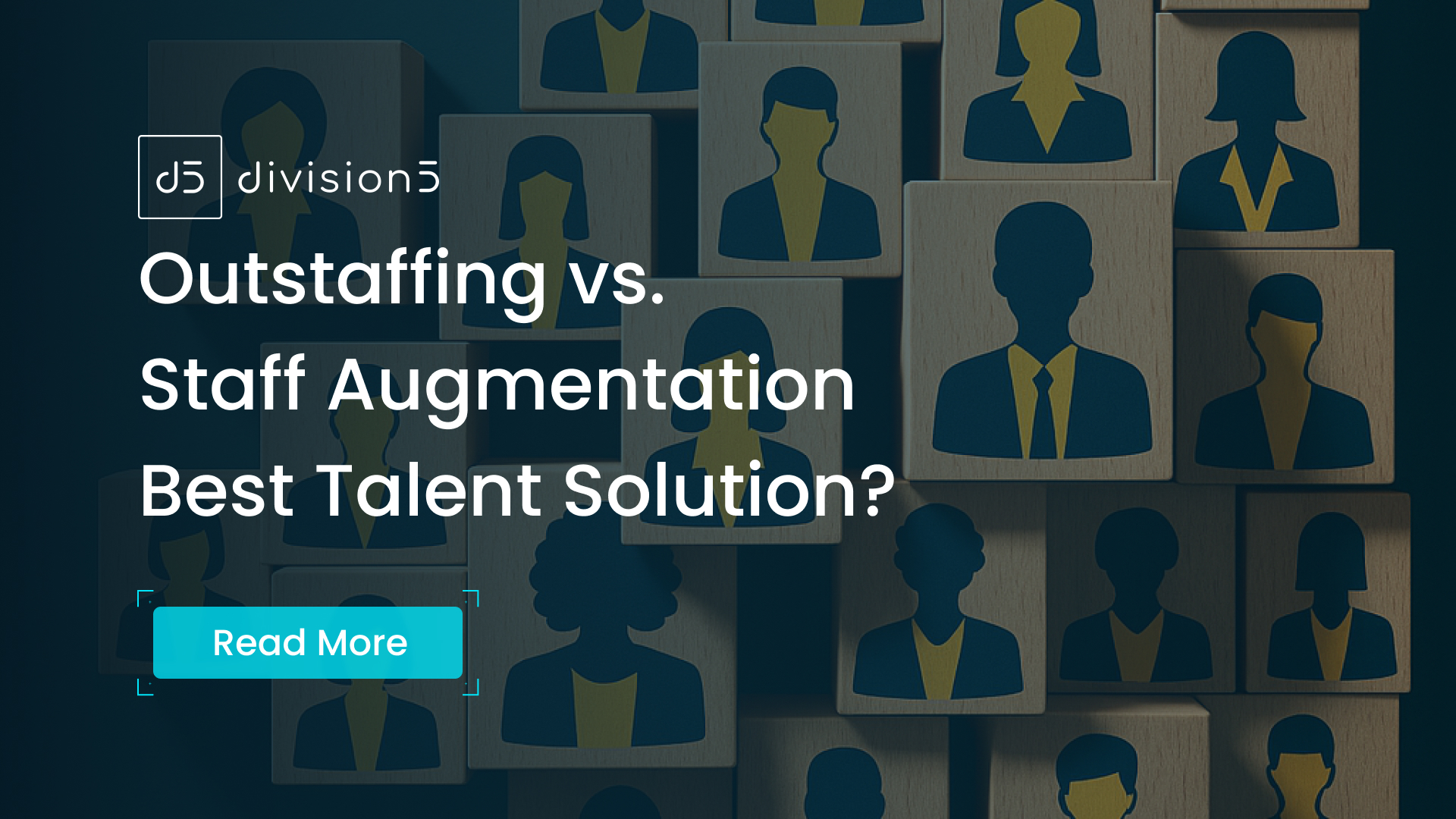
Outstaffing vs Staff Augmentation: Choosing the Right Talent Strategy for Your Tech Needs
Scaling a tech team or finding niche expertise can feel like navigating a labyrinth. You need the right people, fast, without derailing your budget or core mission. Enter the world of external talent solutions: Staff Augmentation and Outstaffing are two terms you’ve likely heard thrown around, often interchangeably. But here’s the deal: they’re not the same. Mistaking one for the other can lead to misaligned expectations, operational friction, and ultimately, hinder your growth.
At division5, we live and breathe technology and understand the crucial role the right team structure plays in delivering impactful software solutions. We’ve seen firsthand how choosing the appropriate talent model can make or break a project. That’s why we’re cutting through the noise.
This comprehensive guide dives deep into the outstaffing vs staff augmentation debate. We’ll unpack exactly what each model entails, lay out the critical differences, explore the pros and cons, and provide clear guidance on which strategy might be the perfect fit for your specific goals – whether you’re a CTO focused on technical integration, a founder prioritizing speed and cost, or a product manager needing adaptable execution. Let’s get started.
Understanding the Basics: Defining the Models
Before we pit them head-to-head, let’s establish a clear understanding of each model. Think of it as knowing your players before strategizing the game.
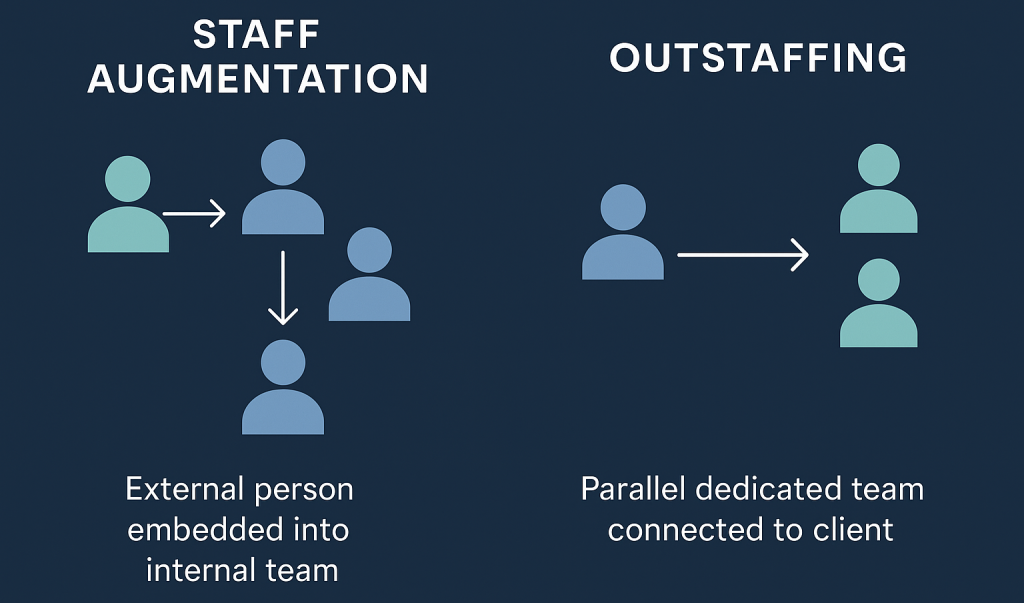
What is Staff Augmentation?
Imagine your current development team is working on a crucial project, but you’re missing a specific skill set – say, a senior DevOps engineer – for the next three months. You don’t need (or want) to go through the lengthy process of hiring a full-time employee for a temporary gap.
Staff Augmentation is the answer here. It’s a flexible strategy where you temporarily add external personnel directly into your existing team structure. These individuals are technically employed by a third-party vendor, but they report to your managers, work alongside your internal staff on your premises (or virtually within your established remote setup), and use your tools and processes.
How Staff Augmentation Typically Works:
- Identify the Gap: You determine the specific skills and duration needed.
- Vendor Sourcing: You partner with a staff augmentation provider (like division5). They present pre-vetted candidates matching your requirements.
- Client Selection: You interview and select the best fit, just as you would for a direct hire, but faster.
- Integration & Management: The selected individual(s) join your team. You manage their daily tasks, project assignments, and performance. The vendor handles payroll, benefits, and basic HR administration.
Key Staff Augmentation Characteristics:
- Focus: Filling temporary skill gaps or boosting capacity quickly.
- Control: High degree of direct management control by the client.
- Integration: Individuals are embedded directly within the client’s existing team structure.
- Vendor Role: Primarily recruitment and basic HR administration.
What is Outstaffing?
Now, imagine a different scenario. You want to build a dedicated team of 3-5 front-end developers to work exclusively on your new web application long-term. You need full control over their work and integration with your processes, but you don’t want the headache of setting up a legal entity in another country, managing foreign payroll, HR compliance, office space, and administrative overhead.
This is where Outstaffing shines. In this model, you partner with an outstaffing services provider who hires professionals specifically for you. These individuals or teams are legally employed by the vendor, who takes care of all HR-related functions: payroll, taxes, benefits, compliance, IT setup, and often office infrastructure if needed. However, these dedicated resources work exclusively on your projects, follow your workflows, and report directly to your project managers or leads regarding tasks and deliverables. They are your team, just employed through a third party.
How Outstaffing Typically Works:
- Define Needs: You specify the roles, skills, team size, and desired location (often leveraging global talent pools).
- Vendor Recruitment & Hiring: The outstaffing vendor recruits, screens, and hires individuals who become their legal employees but are assigned 100% to you.
- Infrastructure & Admin: The vendor provides necessary infrastructure (office space if required, IT equipment) and manages all HR, payroll, and legal aspects.
- Client Management: You integrate the outstaffed team/individuals into your operational structure, managing their tasks, priorities, and project involvement directly.
Key Outstaffing Characteristics:
- Focus: Building dedicated, long-term capacity, often remotely or globally, without direct hiring burdens.
- Control: Client retains full operational control over tasks and projects; vendor handles employment responsibilities.
- Integration: Dedicated team/individuals work exclusively for the client, integrated into their projects and communication channels.
- Vendor Role: Employer of Record, handling full HR, admin, legal, and infrastructure support.
Think of it like this: Staff Augmentation is like bringing in a specialist consultant who sits in your office (real or virtual) and reports to your manager for a specific gig. Outstaffing is like having a dedicated wing of your company operating remotely, fully focused on your work, but managed administratively by an expert partner.
The Core Showdown: Outstaffing vs Staff Augmentation
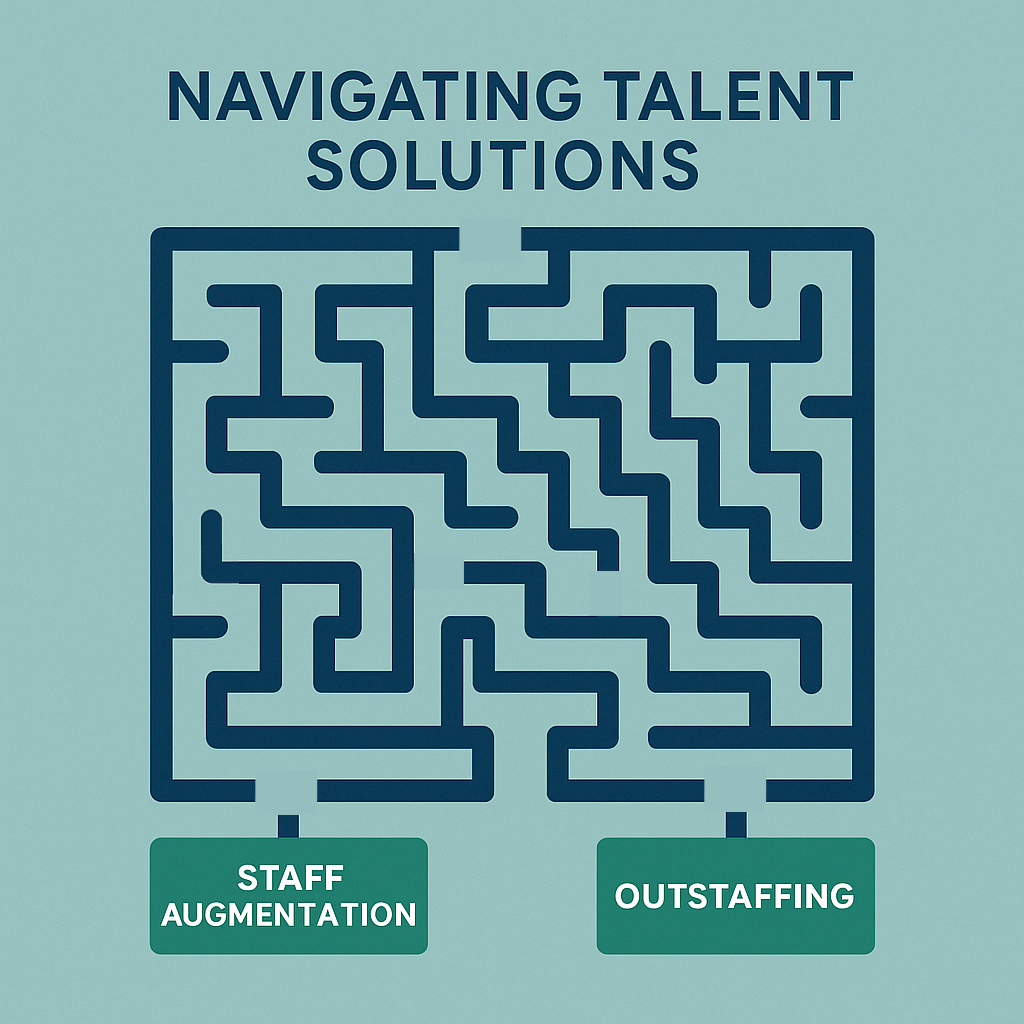
Now that we have the definitions clear, let’s put these two models side-by-side. Understanding these key differences is crucial when choosing between outstaffing and staff augmentation.
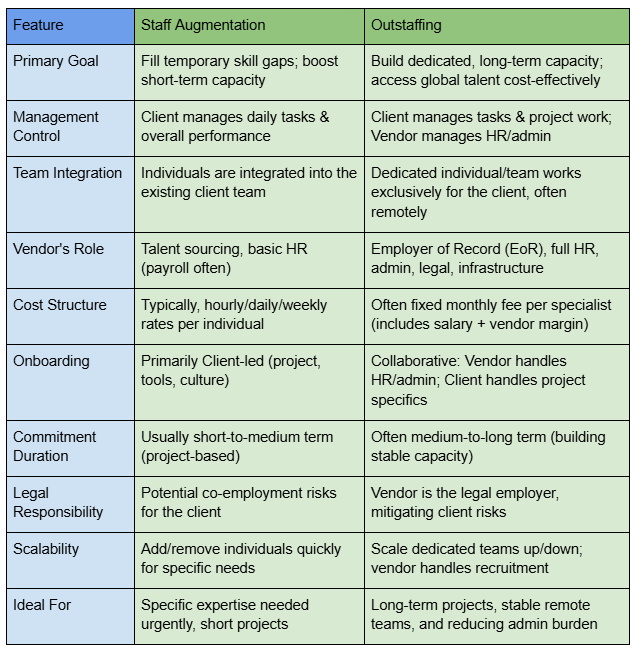
Let’s break down some of these critical points further in the outstaffing vs staff augmentation comparison:
- Management & Control: This is a huge differentiator. With Staff Augmentation, you are hands-on managing the augmented staff member daily, just like any other team member. It requires significant internal management bandwidth. With Outstaffing, while you direct the work, the vendor handles the employment relationship, freeing you from HR burdens associated with that remote team. You focus purely on what they do, not how they’re employed.
- Integration: Staff Augmentation aims for seamless embedding within your current squad. Outstaffing builds a dedicated unit that works for you, integrated into your projects and communication but potentially operating as a distinct (often remote) team.
- Vendor Relationship: In Staff Augmentation, the vendor is primarily a talent pipeline. In Outstaffing, the vendor is a strategic partner, acting as the Employer of Record (EoR) and taking on significant administrative and compliance responsibilities, which is a core part of the outstaffing services value proposition.
- Cost & Commitment: Staff Augmentation offers flexibility, often priced hourly, making it suitable for fluctuating needs. Outstaffing usually involves a monthly fee per specialist, providing cost predictability ideal for stable, long-term team extensions. This predictability is a major draw for founders and business owners focused on budget control.
- Risk: Co-employment laws (varying by region: U.S. DOL’s Co-employment Guidelines, UK GOV: Employment Status) can sometimes create legal complexities in Staff Augmentation if not managed carefully. Outstaffing shifts this employment liability squarely onto the vendor, offering a more risk-mitigated approach for the client, particularly when engaging talent internationally.
Understanding these nuances is the first step toward making an informed decision that truly benefits your unique situation.
Deep Dive: Staff Augmentation – The Flexible Skill Injector
Staff Augmentation is often the go-to for companies needing a quick, targeted boost. Let’s explore its advantages and disadvantages in more detail.
Advantages (Staff Augmentation Benefits):
- Maximum Control: This is arguably the biggest draw. You manage the augmented staff directly, dictating their tasks, methodologies, and priorities just like your internal employees. For CTOs and technical leads, this ensures tight alignment with existing processes and standards.
- Flexibility & Speed: Need a specific expert yesterday? Staff Augmentation allows you to onboard specialized talent much faster than traditional hiring. Scaling down is just as straightforward once the need passes. This agility is gold for project managers juggling tight deadlines and founders needing to pivot quickly.
- Seamless Integration: Augmented staff work shoulder-to-shoulder (physically or virtually) with your team. This facilitates communication, collaboration, and ensures they are deeply embedded in your project’s context and culture.
- Knowledge Transfer: Having external experts work alongside your team can be a fantastic learning opportunity. Your internal staff can gain new skills and insights, boosting overall team capability long after the augmented member departs.
- Cost-Efficiency (Short-Term): For temporary needs, you avoid the significant costs associated with recruiting, hiring, onboarding, and providing benefits for a full-time employee. You pay for the expertise precisely when you need it.
- Access to Specialists: Tap into a pool of specialized talent that might be difficult or too expensive to hire full-time, especially for niche technologies or short-duration requirements.
Disadvantages:
- Management Overhead: That high level of control comes at a cost – your internal managers need to dedicate significant time to supervising, guiding, and integrating augmented staff. This can strain resources if you augment heavily.
- Integration Challenges: While integration is a goal, it isn’t always seamless. Differences in work styles, communication barriers, or lack of cultural fit can arise. Proper onboarding (which falls mostly on you) is critical but time-consuming.
- Scalability Costs: While flexible, relying on augmentation for long-term or large-scale needs can become more expensive than other models due to typically higher hourly rates compared to the blended monthly rates in outstaffing or salaries of direct hires.
- Vendor Dependency & Quality Control: You’re reliant on the vendor’s ability to source quality talent quickly. A poor choice of vendor can lead to delays or underperforming additions to your team. Diligent vetting of both the vendor and the candidates is essential.
- Potential Co-employment Risks: Depending on your location and the specifics of the contract and working relationship, you might inadvertently create a co-employment situation, carrying unforeseen legal and financial liabilities. Consulting legal counsel is often wise.
- Ramp-Up Time: Even with the right skills, new members need time to understand your specific project, codebase, tools, and team dynamics. This learning curve impacts initial productivity.
Ideal Use Cases for Staff Augmentation:
- Short-to-medium term projects requiring specific skills your current team lacks.
- Covering temporary absences like parental leave or sabbaticals.
- Needing to rapidly increase capacity for a critical phase of a project, demanding tight integration and control.
- Projects requiring deep collaboration between internal and external members daily.
- When you have the internal management capacity to oversee augmented staff effectively.
- Situations where knowledge transfer to your internal team is a key objective.
Staff augmentation is a powerful tool for tactical flexibility, allowing you to precisely target skill gaps and capacity needs without long-term commitments. Its success hinges on strong internal management and careful vendor selection.
Deep Dive: Outstaffing – Your Dedicated Global Team Partner
Outstaffing offers a more strategic approach, focused on building dedicated capacity, often leveraging global talent pools while minimizing your administrative burden.
Advantages:
- Reduced Administrative Burden: This is a game-changer. The outstaffing services provider handles everything related to HR: recruitment, payroll processing, tax compliance, benefits administration, local labor laws, etc. This frees up your internal HR and admin teams to focus on your core employees and business strategy – a major win for lean organizations and founders.
- Access to Global Talent Pools: Outstaffing providers often operate in locations with rich tech talent pools and potentially lower operational costs (e.g., Eastern Europe, Latin America, Southeast Asia). This allows you to access top-tier expertise that might be scarce or prohibitively expensive locally.
- Dedicated Resources: Unlike project outsourcing where a vendor team might juggle multiple clients, outstaffed professionals work exclusively for you. They become an integral part of your team, deeply understanding your product, goals, and culture over time, leading to greater stability and commitment.
- Cost Predictability & Potential Savings: You typically pay a fixed monthly fee per specialist. This fee includes the specialist’s salary plus the vendor’s margin covering their services (HR, admin, infrastructure). This predictability simplifies budgeting. Depending on the location, the total cost can often be significantly lower than hiring equivalent talent locally, especially considering loaded costs (salary + benefits + overheads). This directly addresses the cost-saving priority for business owners.
- Simplified Scaling & Risk Mitigation: Need to grow the team? The vendor handles the recruitment pipeline. Need to comply with foreign labor laws? That’s the vendor’s responsibility. Setting up a legal entity abroad? Not necessary. Outstaffing provides a risk-free team scaling pathway, particularly internationally.
- Focus on Core Business: By offloading non-core functions (like remote employee administration), you can concentrate your internal resources and management attention on innovation, product development, and market strategy.
Disadvantages:
- Less Direct “Feel” (Initially): Although dedicated, the team is still employed by another company and often remote. Building a strong team culture and rapport requires conscious effort and robust communication practices.
- Communication & Cultural Overheads: Managing remote, potentially international teams requires excellent communication infrastructure (tools, processes) and sensitivity to cultural differences and time zones. Overcoming these requires proactive management.
- Integration Nuances: While operationally integrated, ensuring the outstaffed team feels like a true part of the company culture requires deliberate effort (e.g., virtual team-building, inclusion in company-wide communications).
- Vendor Lock-in Potential: Transitioning an entire outstaffed team away from a provider can be complex and disruptive. Thorough due diligence and clear contract terms (including exit clauses) are essential.
- Onboarding Coordination: While the vendor handles HR setup, you still need to effectively onboard the team regarding your specific project requirements, technical stack, internal tools, and communication protocols. This requires clear coordination between you and the vendor.
- Quality Depends on Vendor: As with staff augmentation, the success of your outstaffed team heavily relies on the provider’s ability to recruit and retain high-quality talent and provide a supportive working environment for them.
Ideal Use Cases for Outstaffing:
- Long-term projects requiring stable, dedicated development capacity.
- Building full-fledged remote development teams without establishing a foreign legal entity.
- Companies seeking to reduce HR and administrative overhead associated with remote or international staff.
- Leveraging cost-effective global talent pools to access specific skills or manage budgets.
- Situations where operational control is key, but direct employment responsibility is undesirable.
- When predictable monthly costs for dedicated resources are preferred over variable hourly rates.
Outstaffing is a strategic move for businesses looking to build sustainable, dedicated technical capacity efficiently, especially when tapping into the global market. It demands strong communication and a partnership approach with the vendor.
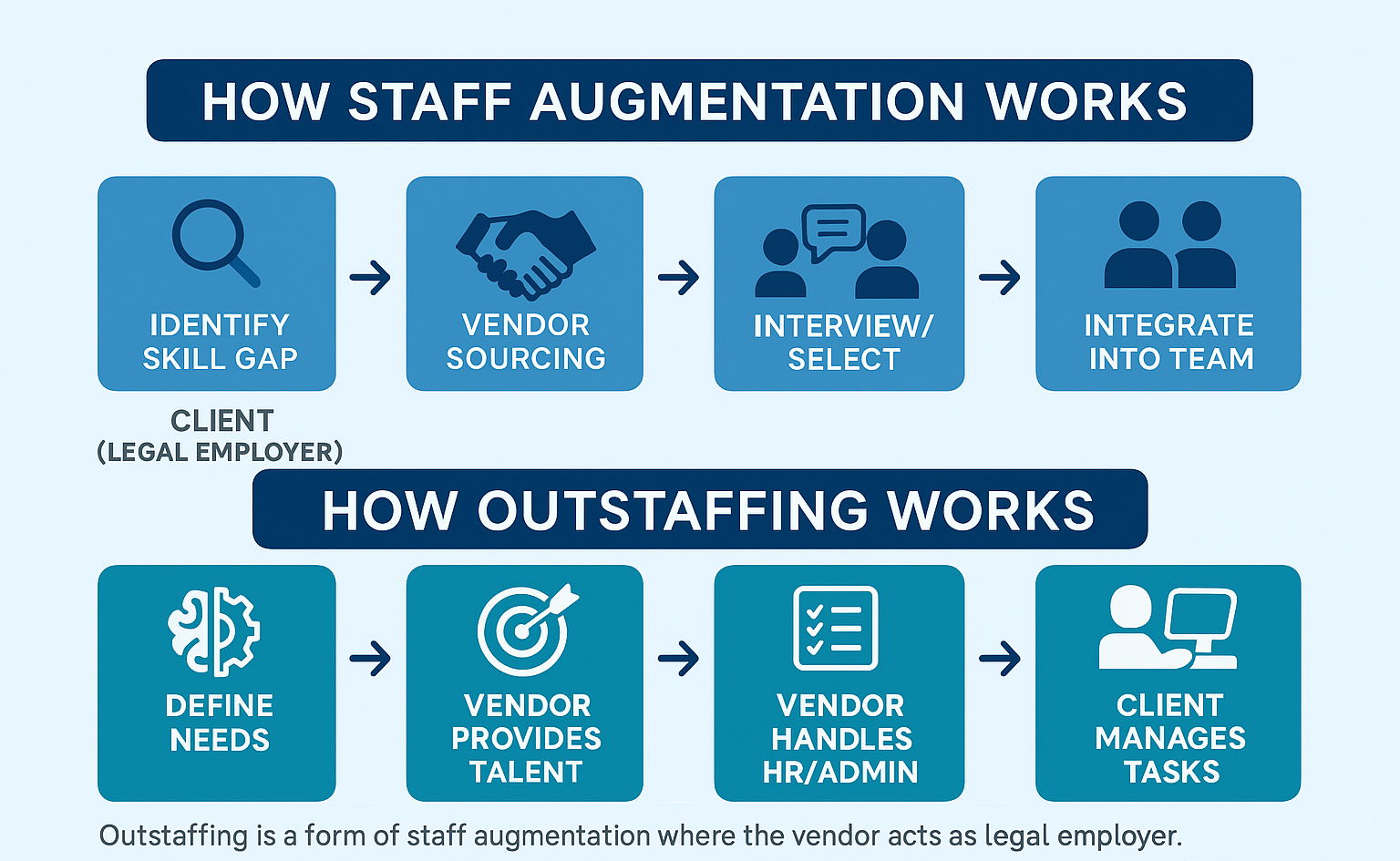
Making the Right Choice: Key Decision Factors
So, the million-dollar question: how do you make the call in the outstaffing vs staff augmentation dilemma? There’s no single “best” answer – the optimal choice depends entirely on your specific context and priorities.
Here’s a framework for choosing between outstaffing and staff augmentation:
- Project Duration & Commitment:
- Short-term (e.g., < 12 months), project-specific need? Lean towards Staff Augmentation.
- Long-term (e.g., 12+ months), ongoing need for stable capacity? Consider Outstaffing.
- Control vs. Admin Burden:
- Need absolute, hands-on daily management similar to internal staff, and have the capacity for it? Staff Augmentation offers this.
- Want full operational control over tasks but wish to offload HR, payroll, and legal employment burdens? Outstaffing is designed for this.
- Budget Structure & Cost Sensitivity:
- Prefer variable costs tied directly to usage (hourly/daily), need maximum flexibility to ramp up/down quickly? Staff Augmentation fits well.
- Need predictable monthly costs per specialist, potentially leveraging global cost advantages for long-term savings? Explore Outstaffing services. (Founders often lean towards this predictability).
- Integration Requirements:
- Need external individuals to deeply embed Staff Augmentation facilitates this best. (Key for CTOs concerned with seamless technical integration).
- Building a distinct, dedicated team that works exclusively for you, integrating at the project/workflow level? Outstaffing excels here.
- Internal Management Capacity:
- Do your managers have the bandwidth to directly supervise and onboard additional individual contributors? Staff Augmentation is feasible.
- Is management capacity strained, or do you prefer managers focus purely on project deliverables rather than personnel admin? Outstaffing reduces this load.
- Scalability Needs & Speed:
- Need to add 1-2 specific roles very quickly for a defined period? Staff Augmentation is often faster for individual roles.
- Need to build or scale a team of several developers/testers/etc., potentially over months, with vendor support for recruitment? Outstaffing provides a structured way to do this. (Addresses speed and scaling for founders).
- Risk Tolerance (Legal & Compliance):
- Comfortable navigating potential co-employment nuances (or operating where risks are low)? Staff Augmentation can work.
- Want to minimize direct employment liability, especially when hiring internationally? Outstaffing (with the vendor as EoR) significantly mitigates this risk.
- Talent Location & Access:
- Need talent that can physically work in your office or within your specific time zone easily? Staff Augmentation might source locally or regionally.
- Looking to tap into broader global talent pools for cost or skill reasons? Outstaffing providers often specialize in specific international markets.
Carefully weigh these factors against your business goals, resources, and project specifics. Sometimes, a blended approach might even be suitable, using augmentation for urgent gaps and outstaffing for core, long-term team extensions.
Contextualizing: How Do They Compare to Other Models?
It’s easy to get lost in the terminology soup. Let’s briefly clarify how Staff Augmentation and Outstaffing differ from other common engagement models:
- vs. Traditional Project Outsourcing: The biggest difference lies in control and focus. In project outsourcing, you hand over an entire project or deliverable to a vendor. You define what needs to be done (the outcome), but the vendor decides how to do it, managing their own team, process, and resources. You have less direct control over the personnel or day-to-day execution. In contrast, both Staff Augmentation and Outstaffing give you direct control over the people and their tasks; the focus is on providing capacity and resources integrated into your workflow, not just delivering a final, packaged result.
- vs. Managed Services: Managed services are similar to outsourcing but typically focus on ongoing management of a specific business function (e.g., IT helpdesk, cloud infrastructure management, cybersecurity monitoring). The provider takes full responsibility for the outcomes and SLAs of that function, often with even less client involvement in the operational details than project outsourcing. Again, the focus is on the service outcome, not providing controllable human resources.
- vs. Direct Contractors/Freelancers: Hiring contractors directly means you are responsible for sourcing, vetting, negotiating contracts, managing payments, and handling all compliance aspects (like worker classification – 1099 vs. W2 in the US). Staff Augmentation and Outstaffing vendors handle much of this administrative overhead. They provide a curated talent pool, manage payroll and basic HR (Augmentation) or full employment (Outstaffing), offer replacement guarantees if someone doesn’t work out, and streamline the engagement process, saving you significant time and reducing risk compared to managing multiple individual contractor relationships directly.
Understanding these distinctions helps solidify where Staff Augmentation and Outstaffing fit within the broader landscape of talent and service delivery models.
Avoiding Pitfalls & Embracing Best Practices
Whichever model you choose, success isn’t guaranteed. Both Staff Augmentation and Outstaffing require careful planning and execution. Here are common pitfalls and best practices:
Common Pitfalls:
- Poor Vendor Selection: Choosing a vendor based solely on price without vetting their recruitment process, talent quality, communication skills, or client testimonials.
- Unclear Roles & Responsibilities: Ambiguity about who manages what (client vs. vendor) leads to confusion and inefficiency.
- Weak Communication Protocols: Not establishing clear channels, meeting cadences, and expectations for remote collaboration, especially crucial for Outstaffing.
- Neglecting Onboarding & Integration: Assuming external staff will just “figure things out” without proper introduction to the project, tools, culture, and team dynamics.
- Ignoring Cultural Differences: Failing to account for varying communication styles, work ethics, or holidays when working with international teams (mainly in Outstaffing).
- Scope Creep (Augmentation): Keeping augmented staff on board indefinitely without reassessing if a more permanent solution (hiring or outstaffing) is needed.
Best Practices for Success:
- Thorough Vendor Due Diligence: Look beyond price. Assess their expertise in your required tech stack, recruitment rigor, communication transparency, client references, and contract flexibility. For Outstaffing, verify their HR/legal compliance capabilities in the relevant regions.
- Crystal Clear Contracts & SLAs: Define roles, responsibilities, deliverables (if applicable), communication expectations, performance metrics, payment terms, data security protocols, intellectual property rights, and exit clauses explicitly.
- Robust Communication Plan: Establish regular check-ins, utilize appropriate collaboration tools (Slack, Jira, video conferencing), document decisions, and foster an environment where questions are encouraged.
- Invest in Onboarding: Dedicate time (from both client and vendor where applicable) to properly introduce new members to the team, project goals, technical environment, and company culture. Assign a buddy or mentor.
- Foster Team Cohesion: Actively include external team members in relevant meetings, social events (virtual or otherwise), and company communications to make them feel part of the team, not just hired hands.
- Regular Performance Reviews & Feedback: Provide constructive feedback and conduct regular performance discussions, just as you would with internal employees, aligning expectations with the vendor.
- Treat Them Like Team Members: Ultimately, whether augmented or outstaffed, these individuals are contributing to your goals. Treating them with respect and integrating them professionally leads to better engagement, loyalty, and results.
Outstaffing vs Staff Augmentation Conclusion: Your Strategic Workforce Choice
Navigating the outstaffing vs staff augmentation landscape doesn’t have to be complicated. By understanding the fundamental differences in control, vendor roles, cost structures, and ideal use cases, you can make a strategic choice that aligns perfectly with your business objectives.
Staff Augmentation offers unparalleled flexibility and control for injecting specific skills directly into your team, ideal for short-term needs and projects demanding deep internal collaboration. Outstaffing provides a powerful mechanism for building dedicated, long-term capacity, leveraging global talent and offloading significant administrative burdens, perfect for strategic team extension and focusing on core competencies.
To better understand which model aligns with your priorities, it’s helpful to consider the lens of different decision-makers. The diagram below highlights how CTOs, founders, and product managers often approach talent strategy based on their specific goals—whether it’s deep technical integration, cost efficiency, or execution flexibility.
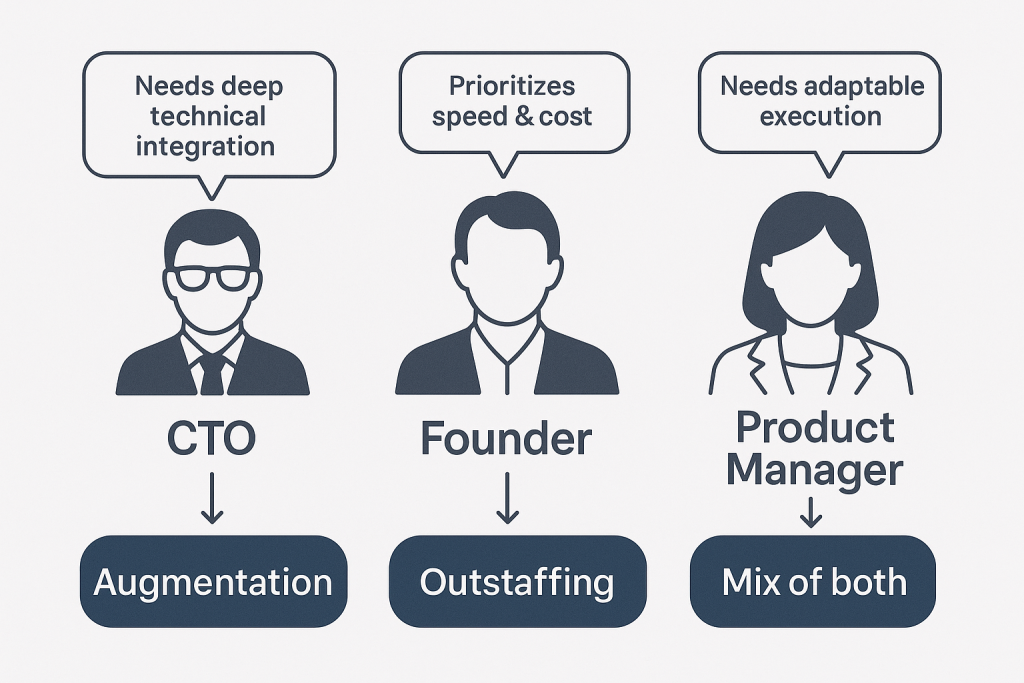
Neither model is inherently superior; the “right” choice is the one that best empowers your team, fits your budget, matches your management style, and accelerates your journey towards delivering impactful software solutions. It’s about selecting the right tool for the job at hand.
Ready to explore which model could unlock your team’s potential?
Choosing the right talent strategy is critical, and we get it. At division5, we’re more than just a software development company; we’re a people-centric partner focused on transparency and results. We specialize in building high-impact teams using models tailored to your unique mission – whether that involves augmenting your current squad or building a dedicated outstaffed unit.
Feeling unsure which path is right for you? Let’s talk. Reach out to division5 today for a straightforward, no-obligation chat. We’ll listen to your challenges and help you determine the most effective way to scale your team and achieve your goals with the right technical expertise and seamless integration.